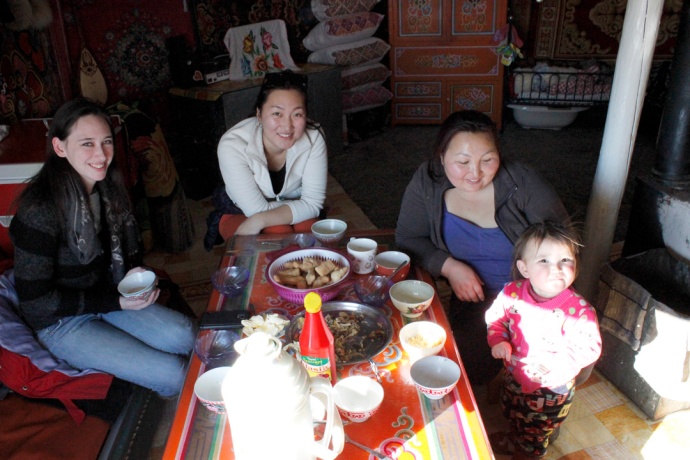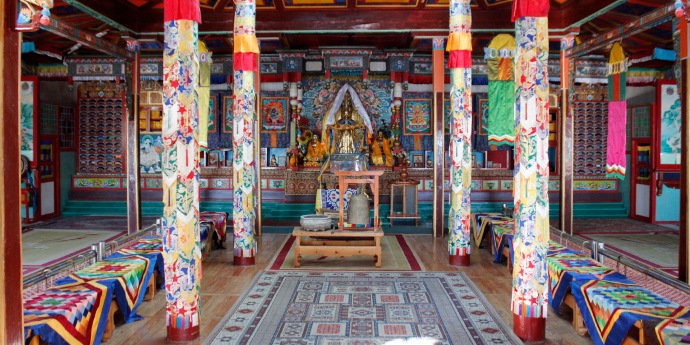After our incredibly eventful and frustrating day in a taxi scam, Jordan and I had tentative hopes for the day tour we’d booked. But it went well! It far surpassed our expectations, and we happily tipped both guide and driver at the end of our day.
Our first stop was in UB, a monument to the Great Patriotic War, more commonly known as WWII. It’s a nice hilltop monument, about 600 steps to the top. Crafted to represent a Mongolian fireplace and the bond between Mongolians and Russians, it commemorates those who fought side by side during the war. It also had a great view of the growing city.

In winter air pollution is particularly bad in UB, mostly because of the cars driven on too-small roads and nomadic families burn lots of coal when they settle on the ouskirts of the city during winter. Over a million people live in UB, and almost every single one has a car. We were surprised to see the roads crowded with Toyota Priuses—by far outnumbering every other car on the road. Our guide mentioned that it’s easy to get a second-hand Prius from Japan for only about 7,000 USD.

Next we traveled out to the east about an hour to the famous Chinggis Khaan statue near Terelj National Park. Chinggis Khaan is the proper way for saying Genghis Khan. He is the most looked up to figure in Mongolia. Though there have been others to unite the nomadic tribes of the steps of Mongolia, Chinggis Khaan is the most revered. He is typically thought to have been a total barbarian but was in fact a noble ruler. He was brutal in battle and conquered land from Korea to Poland with his Horde (that comes from the word ordu, which means court). Scholars estimate the Mongolian invasions killed up to 40 million people, most heavily the Chinese and Iranian/Iraqis.
He was raised as a nomadic hunter who lived a hard life. When they were young, his wife, Borte, was kidnapped by a rival tribe and held for eight months before Chinggis rescued her. Later, when he became Khaan, he saw how this common practice of abduction divided the many nomadic clans and he sought to rectify that and unite them. He raised a small army of horsemen and started conquering group after group, killing their leaders and enveloping the people into his own clan. He forged a great Mongolian Horde that provided many rights to his people, established the largest most extensive trade network of the time from modern day China to Syria and Turkey in what we know as the Silk Road.
According to the Lonely Planet guidebook, he was one of the first to allow diplomatic immunity to foreign emissaries and treated them with respect instead of killing them like was common in his day. The Mongolians under Chinggis Khaan flourished not only in war and trade but also in art. They embellished pottery, instruments, clothing, saddles and much more.

The 40-meter tall statue faces the lands that he grew up in, also the direction of where he is believed to have been buried. The men who buried him were killed when they came back so nobody would know his burial location. The statue itself is where legend says Chinggis Khan found his famous golden whip before he became the great Khaan. When he died his empire was divide primarily amongst his four favorite sons. In fact, the famous Golden Horde was ruled by one of the Great Khaan’s sons in northern Mongolia and parts of Russia. The Mongolians slowly splintered into smaller hordes over the 1200s. One of his grandsons even founded the Yuan Dynasty in China and took on many Chinese customs. The great empire of the Mongols, descendents of Chinggis, fought for power until eventually the clans reverted back to their previous cultures in areas like Russia, Kazakhstan, and China.
In 2006 a wealthy Mongolian businessman decided to build the monument to increase tourism and encourage Mongolians to appreciate their history. The complex has the largest traditional leather boot, made out of 40 cowhides. In the basement is a small museum and a lift to the top of the horse’s head. It’s like 7,000 MNT to get in but it was included in our tour. They also showed us a video of how they built the statue and the plans they have to develop the area into a cultural center complete with tourist gers to stay the night in and traditional Mongolian shows, demonstrations, and activities.

After that, we headed into the Terelj National Park and had lunch with a local Kazakh family. They are nomadic and move their herd around Mongolia in search of good grazing grounds. They move about four times a year and usually spend the winter in Terelj. We had a very flavorful meal, which is not usual for Mongolian food, I am told, but this was good. Our host made hand-shaved noodles, beef, carrots, and potatoes complete with bland bread cookies and Kazkh-style milk tea. Milk tea is a big thing in Mongolia, which is exactly what it sounds like: heavily salted tea steeped in milk.

The tradition table, painted bright orange, has symbols for life and prosperity painted on it.

Their winter ger is one room, with plaster walls in a circle, just like their tent summer ger, with a heater in the middle. Outside were more square buildings like barns and outhouses.

I had about 15 cookies, 4 bowls of the pasta mixture, and 3 bowls of milk tea. We talked a little with our hosts (through our guide as translator) and admired their toddler. I was surprised to find that they have wifi and great radio in the winter house. The father/husband found out we were American and asked about the election and if we voted. Adrianne and I grimaced and said we were in Korea at the time. After eating everything I could, we thanked them and headed off for Aryapala temple and meditation center.

The Chinese in the 19th century and the Soviets in the 20th century wiped out most monasteries in Mongolia. The country practices primarily Tibetan Buddhism (much to China’s chagrin and frustration) and a mix of Hinduism and Animism. A few Kazakh Mongolians in the west are Muslim. This temple was built in the mid 20th century to look like a white elephant—the stairs (108, of course) are the trunk and the wings of the shrines are its ears. The center was mostly closed, so we didn’t get to hear monks chanting, but a nice monk did unlock the door so we could take a peek inside and see paintings of the spiritual protectors of Mongolia as well as enlightened beings under Buddha’s influence (similar to Christians saints). The view from the top was inspiring, to say the least. Even with the barren trees, the steppes were gorgeous.

Mongolians love horses. They were some of the first to domesticate wild horses, and the locals say that their children learn to ride a horse before they’re weaned (this is probably true). So we got a chance to do a short horse trek through the valley. We had some trouble with our horses wanting to leave the warmth of the stable, but the guide got them out. They are hairy for the winter, but shed it all in the summer. We were led like children on our horses, until we were frozen through, upon which we headed back. The horses just wanted to be back in the barn and knew the way, but it felt like a more of a ride because we weren’t being pulled along and seemed to now have some control over them.

We warmed up in one of the gers with more local Mongolians. At this point some of the details of our taxi scam came out, upon which they suggested I should have head budded, punched, or kicked they guy for ripping us off. It made us laugh and made me happy to know that it wasn’t just offensive to us but to the locals as well. We finished up and headed back to Ulaanbaatar, where our guide and driver dropped us off at the big department and shopping center in town.


Recent Comments